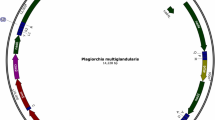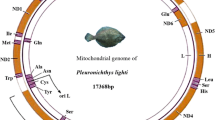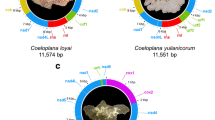Abstract
Among invertebrates, only a few groups still have uncertain phylogenetic position, Orthonectida, a small group of rare multi-cellular parasites of marine invertebrates, being one of them. Recent molecular and morphological findings suggest that orthonectids belong to Lophotrochozoa and are close to Annelida. Nevertheless, phylogenetic relationships between orthonectids and annelids are unclear, and the phylogeny within the group itself has never been studied. Sequencing of mitochondrial genomes is used here to clarify this issue. Complete mt genomes of the orthonectids Intoshia variabili and Rhopalura litoralis were characterized and compared with Intoshia linei mt genome. Our results show that Orthonectida mt genomes have undergone reduction and gene loss, and that they have complicated organization revealed in strand asymmetry in nucleotide composition, in some features of intergenic non-coding regions, tRNA duplication and folding. Moreover, all species of Orthonectida have a unique gene order with complicated rearrangement landscape. Significant differences in mitochondrial genomes in the three orthonectid species could be explained by the fact that their host species belong to different taxa (flat worms, nemertines and gastropods). Among the analyzed mt genomes of Orthonectida, I. linei possesses the closest gene order to the ancestral genome. All Orthonectida species are monophyletic, and in the phylogenetic tree are close to Pleistoannelida, and specifically, to Clitellata.








Similar content being viewed by others
Abbreviations
- cox1, cox2, cox3 :
-
Cytochrome oxidase subunit I, II, and III protein genes
- cob :
-
Cytochrome b gene
- atp6, atp8 :
-
ATP synthase subunit 6 and 8 gene
- nad2, nad4, nad4L, nad5, nad6, nad11 :
-
NADH dehydrogenase subunit 1–6, 11 and 4L genes
- \(tRN{A^{Trp}}\), tRNA Ile, RNA Lys, tRNA Met, tRNA Val, tRNA Cys, tRNA Met, tRNA Gln, tRNA Leu1, tRNA Leu2, tRNA Phe, tRNA Arg, tRNA Tyr, tRNA Ser1, tRNA Ser2, tRNA Asp1, tRNA Asp2, tRNA Asn :
-
Transfer RNA genes
- rrnL, rrnS :
-
Ribosomal RNA genes
- ORF:
-
Open reading frames
- PCG:
-
Protein-coding gene
References
Abascal F, Zardoya R, Posada D (2006) GenDecoder: genetic code prediction for metazoan mitochondria. Nucleic Acids Res 34:389–393
Altschul SF, Madden TL, Schaffer AA, Zhang J, Zhang Z, Miller W, Lipman DJ (1997) Gapped BLAST and PSI-BLAST: a new generation of protein database search programs. Nucleic Acids Res 25:3389–3402
Bankevich A, Nurk S, Antipov D, Gurevich A, Dvorkin M, Kulikov AS, Lesin V, Nikolenko S, Pham S, Prjibelski A, Pyshkin A, Sirotkin A, Vyahhi N, Tesler G, Alekseyev MA, Pevzner PA (2012) SPAdes: a new genome assembly algorithm and its applications to single-cell sequencing. J Comput Biol 19:455–477. https://doi.org/10.1089/cmb.2012.0021
Bernt M, Merkle D, Ramsch K, Fritzsch G, Perseke M, Bernhard D, Schlegel M, Stadler PF, Middendorf M (2007) CREx: Inferring genomic rearrangements based on common intervals. Bioinformatics 23:2957–2958
Bernt M, Braband A, Schierwater B, Stadler PF (2013) Genetic aspects of mitochondrial genome evolution. Mol Phylogenet Evol 69:328–338
Boore JL (1999) Animal mitochondrial genomes. Nucleic Acids Res 27:1767–1780
Castresana J (2000) Selection of conserved blocks from multiple alignments for their use in phylogenetic analysis. Mol Biol Evol 17:540–552
Curole JP, Kocher TD (1999) Mitogenomics: digging deeper with complete mitochondrial genomes. Trends Ecol Evol 14:394–398
Darling AE, Mau B, Blatter FR, Perna NT (2004) Mauve: multiple alignment of conserved genomic sequence with rearrangements. Genome Res 14:1394–1403
Gissi C, Iannelli F, Pesole G (2008) Evolution of the mitochondrial genome of Metazoa as exemplified by comparison of congeneric species. Heredity 101:301–320
Gouy M, Guindon S, Gascuel O (2010) SeaView version 4: a multiplatform graphical user interface for sequence alignment and phylogenetic tree building. Mol Biol Evol 27:221–224
Gurevich A, Saveliev V, Vyahhi N, Tesler G (2013) QUAST: quality assessment tool for genome assemblies. Bioinformatics 29:1072–1075. https://doi.org/10.1093/bioinformatics/btt086
Kozloff EN (1992) The genera of the phylum Orthonectida. Cah Biol Mar 33:377–406
Lartillot N, Philippe H (2004) A Bayesian mixture model for across-site heterogeneities in the amino-acid replacement process. Mol Biol Evol 21:1095–1109
Lowe TM, Eddy SR (1997) tRNAscan-SE: a program for improved detection of transfer RNA genes in genomic sequence. Nucleic Acids Res 25:955–964
Metschnikoff E (1881) Untersuchungen über Orthonectiden. Zeitschrift fuer Wissenschaftliche Zoologie 35:282–303
Mikhailov KV, Slyusarev GS, Nikitin M, Logacheva MD, Penin AA, Aleoshin VV, Panchin YV (2016) The genome of Intoshia linei affirms orthonectids as highly simplified spiralians. Curr Biol 26:1768–1774
Perna NT, Kocher TD (1995) Patterns of nucleotide composition at fourfold degenerate sites of animal mitochondrial genomes. J Mol Evol 41:353–358
Plazzi F, Puccio G, Passamonti M (2016) Comparative large-scale mitogenomics evidences clade-specific evolutionary trends in mitochondrial DNAs of Bivalvia. Genome Biol Evol 8:2544–2564. https://doi.org/10.1093/gbe/evw187
Rambaut A, Drummond AJ (2009) Tracer version 1.5. http://tree.bio.ed.ac.uk/software/tracer/. Accessed 30 Nov 2009
Rota-Stabelli O, Yang Z, Telford M (2009) MtZoa: a general mitochondrial amino acid substitutions model for animal evolutionary studies. Mol Phylogenet Evol 52:268–272
Rota-Stabelli O, Kayal E, Gleeson D, Daub J, Boore JL, Telford MJ, Pisani D, Blaxter M, Lavrov DV (2010) Ecdysozoan mitogenomics: evidence for a common origin of the legged invertebrates, the Panarthropoda. Genome Biol Evol 2:425–440. https://doi.org/10.1093/gbe/evq030
Schiffer PH, Robertson HE, Telford MJ (2018) Orthonectids are highly degenerate annelid worms. Curr Biol 28:1970–1974. https://doi.org/10.1016/j.cub.2018.04.088
Shtein GA (1953) Ortonektidy roda Rhopalura Giard nekotorykh molliusko v Barentsova moria. Uchenye Zapiski Karelo-Finskogo Universiteta. Biol Nauki 5:171–206
Slusarev GS (2018) Ortonectida. Miscellaneous Invertebrates. Handbook of Zoology. https://www.degruyter.com/view/Zoology/bp_048833-3_2. Accessed 26 Oct 2018
Slyusarev GS (1994) The fine structure of the female Intoshia variabili (Alexandrov & Sljusarev) (Mesozoa: Orthonectida). Acta Zool 75:311–321
Slyusarev GS, Ferraguti M (2002) Sperm structure of Rhopalura litoralis (Orthonectida). Invertebr Biol 121:91–94
Tesler G (2002) GRIMM: genome rearrangements web server. Bioinformatics 18:492–493
Weigert A, Golombek A, Gerth M, Schwarz F, Struck TH, Bleidorn C (2016) Evolution of mitochondrial gene order in Annelida. Mol Phylogenet Evol 94:196–206
Wey-Fabrizius AR, Podsiadlowski L, Herlyn H, Hankeln T (2013) Platyzoan mitochondrial genomes. Mol Phylogenet Evol 69:365–375. https://doi.org/10.1016/j.ympev.2012.12.015
Acknowledgements
We are thankful to Dr. M. Makarov for providing accommodation and facilities for field work at the Barentz Sea, and also to the staff of the Marine Biological Station of the Saint Petersburg State University for assistance in collecting material. The work was supported by Grant of Russian Foundation for Basic Research (RFBR) no. 19-04-0021 and Saint Petersburg State University research Grant 1.40.496.2017. Bioinformatics was supported with Russian Science Foundation 17-74-10103 Grant to Natalya Bondarenko. This study utilized equipment of the “Centre Biobank” and “Computing Centre SPbU” of Saint Petersburg State University.
Author information
Authors and Affiliations
Corresponding author
Additional information
Communicated by B. Franz Lang.
Publisher’s Note
Springer Nature remains neutral with regard to jurisdictional claims in published maps and institutional affiliations.
Rights and permissions
About this article
Cite this article
Bondarenko, N., Bondarenko, A., Starunov, V. et al. Comparative analysis of the mitochondrial genomes of Orthonectida: insights into the evolution of an invertebrate parasite species. Mol Genet Genomics 294, 715–727 (2019). https://doi.org/10.1007/s00438-019-01543-1
Received:
Accepted:
Published:
Issue Date:
DOI: https://doi.org/10.1007/s00438-019-01543-1




